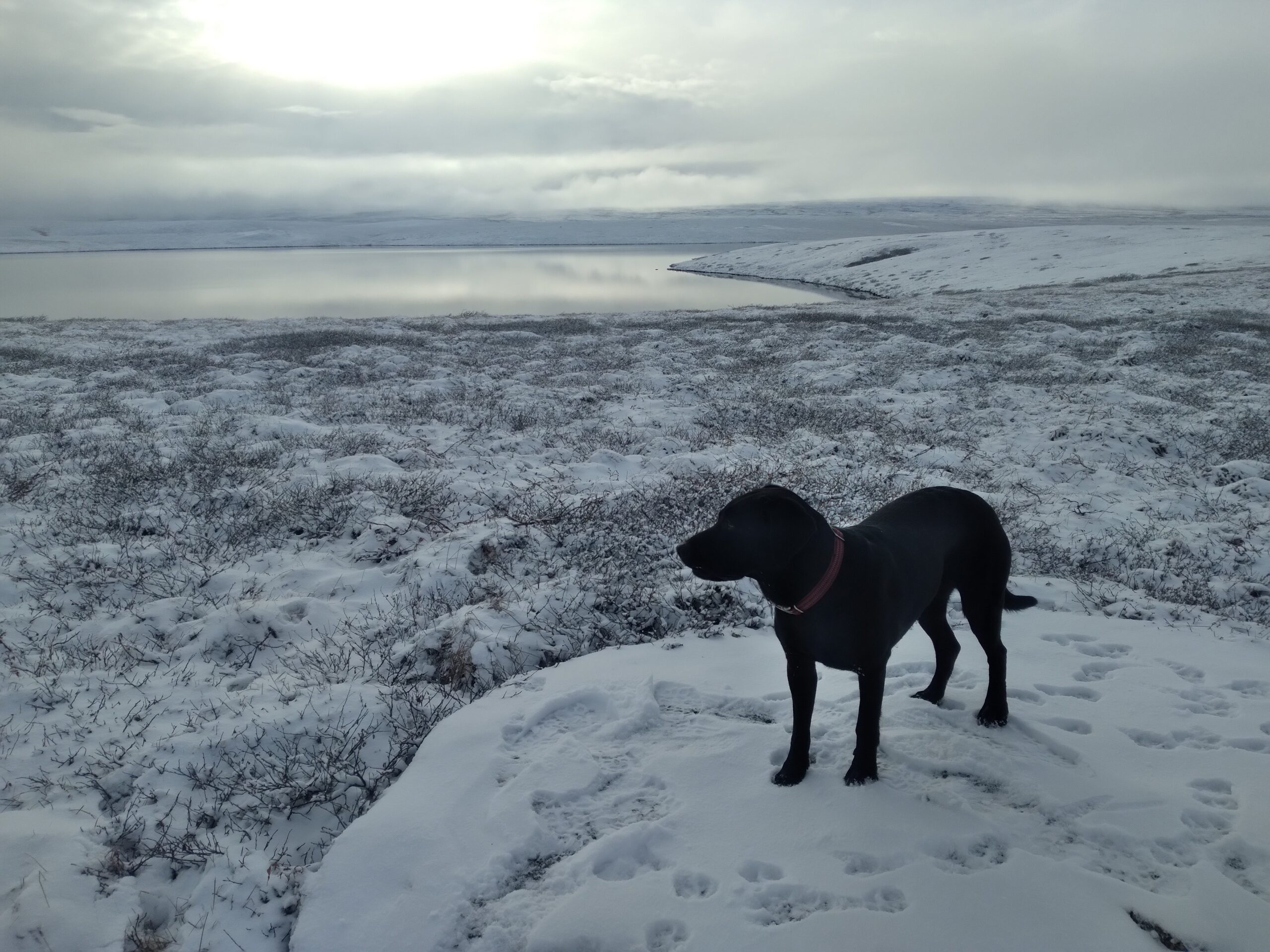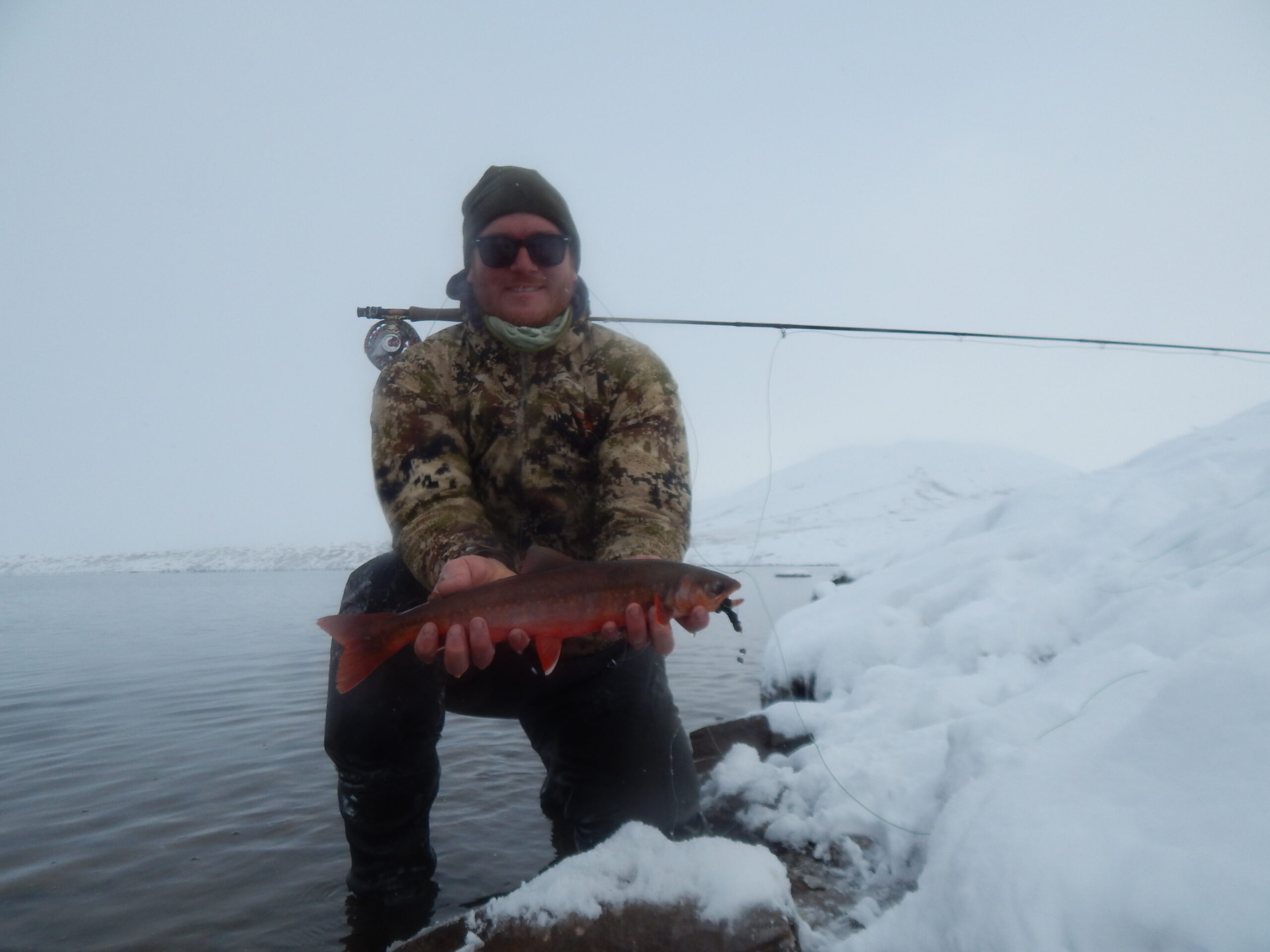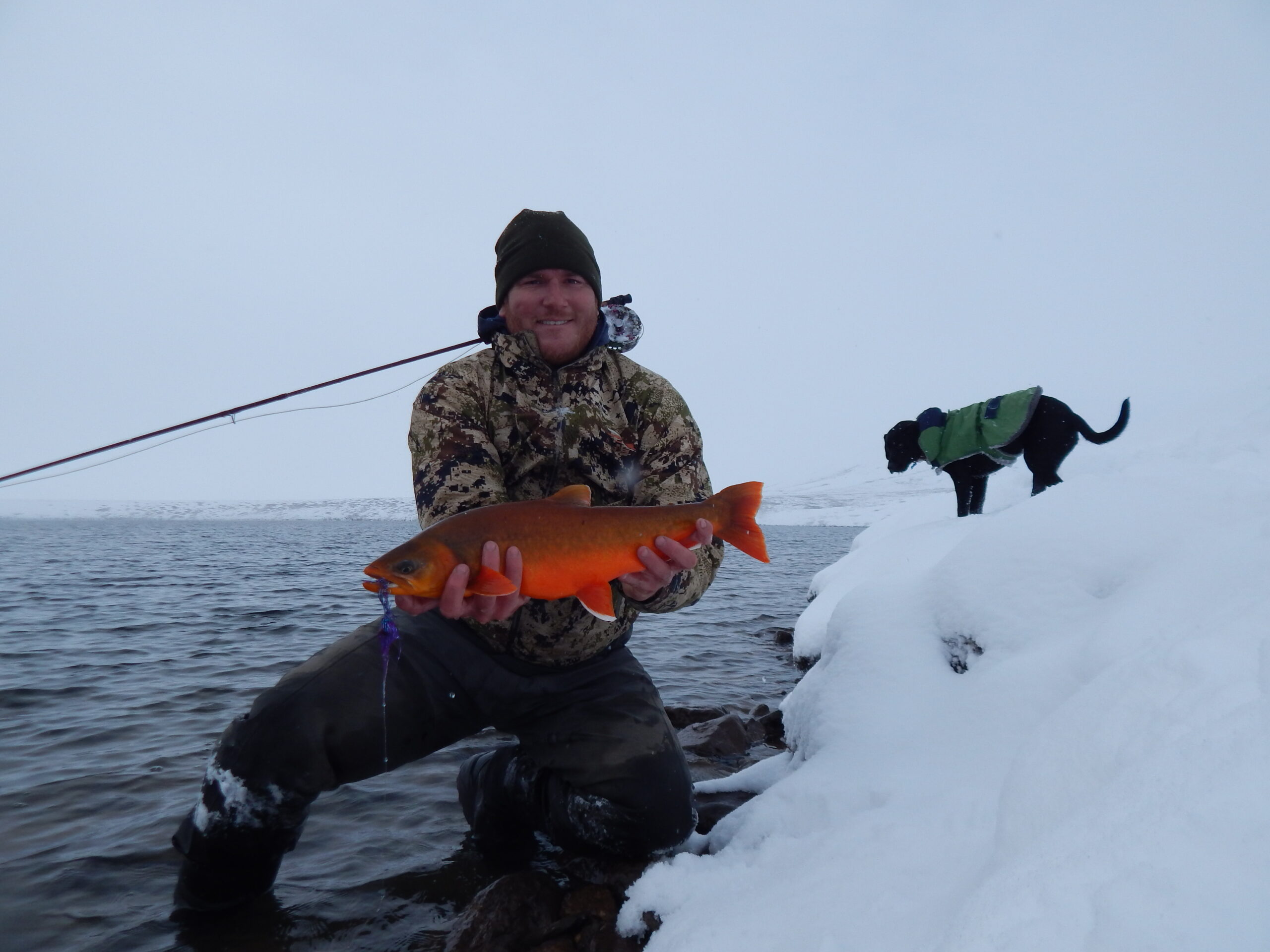Fly fishing for the world’s most colorful salmonid along Alaska’s famed Haul Road
Thick mud flew from the truck tires and rattled against the wheel wells as I drove up northern Alaska’s vaunted Dalton Highway. Dirt-covered semi-trucks whooshed past in the opposite direction, hauling fuel tanks and heavy equipment. Other than industrial traffic, few people traveled the Haul Road. Fairbanks had just received its first snowfall of the season, and all my fellow Alaskans were rushing to complete autumn chores rather than heading out for ill-advised outdoor excursions.
The copilot on this adventure, my three-year-old black lab Dolly (named after the fish, not the singer) stared intently out the passenger window, looking for roadside grouse. Dolly and I were headed north towards the North Slope, a tundra plain extending from the northern foothills of the Brooks Range to the barren Beaufort Sea coast. The objective of the trip was to hike across the tundra to fish a pothole lake that contained wild Arctic char.

Going the Distance
October is not considered an ideal time to travel the Haul Road looking for fish to catch. Typically, snow already blankets the ground, lakes and rivers are partially frozen, and shorter daylight hours mean less time hiking and fishing. However, I was determined to catch my first wild Arctic char on a fly rod, and the North Slope was the place to do it because of the limited geographic range in Alaska where these fish are found.
We worked our way north from Fairbanks along over 400 miles of muddy, slushy road, crossing the Yukon River, passing the Arctic Circle, and stopping briefly at the Coldfoot truck stop for overpriced fuel and coffee. We then entered the foothills of the Brooks Range, and mud turned to slush and ice. Gray, angular mountains in Gates of the Arctic National Park could be seen on our left, while peaks in the Arctic National Wildlife Refuge were visible on our right. Slowly ascending Atigun Pass, infamous for poor weather and slippery conditions, we crossed the Arctic Divide and entered winter. Several inches of snow covered the gray shale slopes and tundra foothills north of the range. Lines of caribou stood out across the snowy landscape, some even ambling across the road in front of us.
Driving through the Galbraith Lake area, which includes lakes that hold Arctic char, I thought about the many pressures facing these fish, and how to balance the priorities of competing user groups on these public lands. The Bureau of Land Management is currently determining the future management of 13 million acres of public lands and waters in this region. As part of the Central Yukon Resource Management Plan, hunters and anglers have an opportunity to ensure that key species like Arctic char, Dall Sheep, and caribou receive adequate habitat safeguards so future generations may continue to enjoy the same hunting and fishing traditions.
Not long after passing through the Galbraith Lake area, we reached our hopping-off point where we would begin our hike.
When selecting a lake to fish, the options overwhelmed me, but I was able to rely on a skill I learned through my job as a fisheries biologist: delving through data. Luckily, if you know where to look, historic scientific reports can give you some starting points. Armed with closely-guarded GPS coordinates, I believed I had found what I was seeking.
Loading up my pack, I started hiking out across the snowy tundra. Dolly raced back and forth over the frozen grass tussocks, not realizing we had several miles to travel. We soon left the sights and sounds of the road behind. A curious band of cow and calf caribou trotted towards us, getting within 200 yards before noticing Dolly’s wolf-like shape and beating a hasty retreat. After hours and miles of hiking, we reached our lake and set up camp. Its unfrozen waters gleamed like a chunk of obsidian framed in the ivory snow.

Iced Guides and Bunny Leeches
The next morning broke foggy and cold. We stayed in the tent until 10am, when the sun started peeping through the mist and the air temperature rose. Because I didn’t want to leave Dolly behind, I decided to fish from shore and work my way around the lake rather than troll in the packraft. The lake surface was calm and the water clear.
After about a mile circumventing the shoreline, I noticed the gravel shallows transitioned into a rocky dropoff. I cast out into the deep water, pausing every fifth retrieve to break ice out of the rod guides. I was fishing with a weighted black leech, suggested by a friend. Dolly was playing along the shoreline ahead, and we were both startled by a loud swirl about 50 feet down the bank. I caught a glimpse of two yellowish shapes cutting through the shallows to deeper water. We had found the char.
Arctic char are autumn-spawning fish, and like many salmonids, they exhibit several physical changes during their spawning period. These typically include a shift to brighter colors for both sexes and the development of a hooked jaw, or kype, in males. In the case of Arctic char, particularly those of Alaska’s North Slope, males can adopt an otherworldly orange or yellow color that undoubtedly wins them the title of most colorful salmonid. I had seen pictures of char in that sort of regalia, and I was after one of these orange “pumpkins.”
Finally seeing these fish brought on buck fever, and it took me what seemed like an eternity to break ice off my guides and sling an inelegant cast towards the area where the char had disappeared. I wasn’t sure what to expect—perhaps they were spooked and would not now bite? I didn’t have to worry. As I stripped the leech out of the deep and up into the rocky shallows, a yellow submarine was in pursuit.
I saw the flash of a white mouth open but set the hook too early. Cursing at myself, I calmed my nerves and cast to the waiting char hovering by the dropoff. Without reserve, the smaller, drabber female grabbed the leech and I set the hook. After a short but active fight, I brought her in to the rocky shore and let her rest in the shallows while I set up my camera for a self-portrait. Dolly came up and sniffed at the fish, excited by the sudden activity. I lifted the char out of the water for the photo, its bright red belly gleaming like a ruby. I placed it back in, flipped the hook out of its mouth, and it slowly finned its way out into the deep.
My hands ached from the cold water, and I warmed them on my bare neck to regain function. After allowing myself a moment of celebration, I cast the leech back out in hopes that the more brightly-colored fish would return. And here he came, chasing the fly up to the shallow shelf. But he would not strike, only follow. This repeated a couple more times until the fish grew bored and dissolved back into deeper water. Disheartened, I kept moving along the bank, hoping to find more fish.

After another half hour of fruitless casting, I decided to double back to where I’d had action. I thought about another friend who had caught North Slope char on silvery, brightly colored spoons, and this inspired me to try a different fly. With faint hope, I tied on a flashy, bright purple articulated salmon streamer. Casting out as far as I could, I stripped the fly back in and held my breath. As the fly neared the shallows, I could see the big orange male char was following it.
This time, before the streamer cleared the dropoff zone, I felt a sharp tug and set the hook. The fish of dreams was on the line. The several-pound char dove, cavorted, and pulled strongly. I took extra care to fight the fish to ensure I wouldn’t break my leader. Several times I thought he was ready to come to shore, but as his belly felt the lake’s bottom, he suddenly rushed back out into deeper water. Finally, I brought the gleaming fish into the rocky shallows.
It was a perfect, bright orange male Arctic char. The white-edged pectoral fins added an additional accent to an already-stunning fluorescent display. I took a self-timed shot holding the fish while Dolly raced back and forth on the bank, excited about the splashing but unwilling to enter the cold water. After the shutter closed, I unhooked the fish, and it shot off to join its pal in deeper water. I ran back and forth on the snowy bank to warm my body up; I was ecstatic. After years of plotting and planning, I had finally caught the Arctic char of a lifetime on a fly rod, that perfect “pumpkin spice” specimen.

Through the morning and early afternoon, I fished a nearby transition zone where the rocky shelf met a weedbed. Here, my luck continued, and I caught another half-dozen Arctic char, plus a lone lake trout, on the salmon streamer. Just after lunchtime, I felt satisfied with the day’s work and hiked back to camp. Realizing that I couldn’t improve much on a stellar day’s fishing, I decided to pack up and hike out early rather than stay one more night as planned. The goal of a Coldfoot truck stop burger loomed in my mind as Dolly frolicked through the whiteout ahead of me on our backtrail.
Essential to Happiness
The public lands extending five miles of both sides of the Haul Road—including the country we crossed on our hike, and the lake containing the char—are managed by the BLM as a critical component of our domestic oil and gas transportation system. At first blush, that may not sound like a recipe for world-class hunting and fishing opportunities.
But current restrictions on industrial mining and motorized use in the Dalton Highway Corridor help facilitate some of the wildest yet accessible backcountry fishing and hunting experiences you’ll find anywhere. Savoring the views of the craggy mountains, open tundra adorned with snow, braided creeks, and gleaming lakes, I reflected on how different this landscape might look in a few years if these public lands were opened to more intensive development activities.

The future management of 13 million acres of public land in Northern Alaska—including the Dalton Highway Corridor and the Middle Yukon and Koyukuk watersheds—is currently under review by the Bureau of Land Management. The agency is in the process of revising the Central Yukon Resource Management Plan (RMP), a process that happens roughly every 20 years. The draft plan, developed under the previous administration, recommended opening approximately 98 percent of these lands to industrial mineral development.
In response, more than 500 hunters and anglers took action and urged the BLM to expand public access for hunting, angling, and other forms of wildlife-dependent recreation in the Dalton Highway Corridor. Sportsmen and sportswomen also advocated for stronger safeguards for important caribou and Dall sheep habitat in the region.
A favorite quote from wilderness advocate Bob Marshall sprang to mind as Dolly and I crossed the expanse: “For me, and for thousands with similar inclinations, the most important passion of life is the overpowering desire to escape periodically from the clutches of a mechanistic civilization. To us the enjoyment of solitude, complete independence, and the beauty of undefiled panoramas is absolutely essential to happiness.” I hoped I’d be able to continue to visit this undegraded land of caribou and Arctic char, which to me is certainly an experience “essential to happiness.”
Kevin Fraley is a fisheries ecologist for the Wildlife Conservation Society based in Fairbanks, AK, and enjoys hunting, fishing, and rafting throughout Alaska. Click here to learn more about the research Kevin leads for WCS.
Photo Credits: Kevin Fraley





Thanks for a good story/article from someone that can only dream of such treks now.